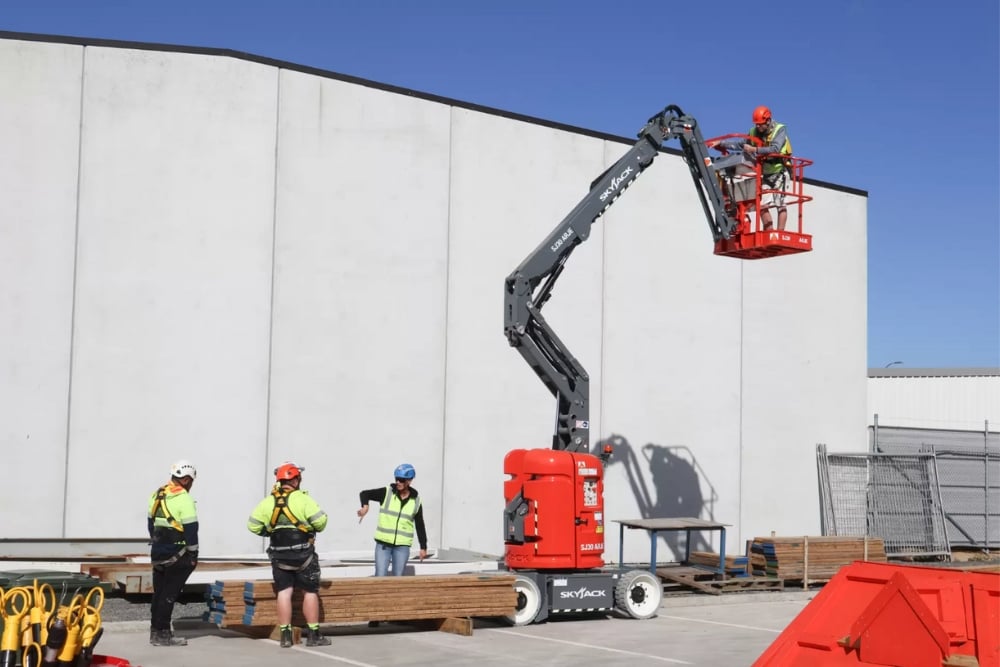MEWP Safety: Best Practices and Key Considerations
Trade Advice
The following expert advice has been provided by Kennards Hire premium supplier and leading global manufacturer, SkyJack.
Mobile Elevating Work Platforms (MEWPs) are essential tools for working at height safely and efficiently. Commonly used in construction, maintenance, and warehousing, MEWPs include boom lifts, scissor lifts, and vertical mast lifts. While these machines are designed with safety in mind, understanding MEWP safety is critical.
One of the first steps in MEWP safety is proper training. Operators must complete certified training programs that cover both theory and practical application. This training should include safe operating procedures, hazard recognition, emergency controls, and how to perform pre-use inspections.
A thorough pre-use inspection is non-negotiable. Before operation, check the equipment for signs like visible damage, tire or wheel issues, and functionality of all safety devices.
Pre-use inspections should also include the job site as well. Ensure that there are no hazards or obstacles in the path of the machine and confirm the ground conditions are suitable for the lift in operation. It is also crucial to note overhead obstacles. For example, when working outside operators should be aware of, and maintain a safe distance from power lines. Indoors, it is also wise to note things overhead such as HVAC ductwork or sprinkler systems.
Weather conditions must also be assessed before operating a MEWP. High winds, lightning, or heavy rain can make elevated work unsafe. Most MEWPs have wind speed limitations noted by the manufacturer—always follow those guidelines.
Fall protection is another vital aspect. Depending on the type of MEWP, operators may be required to wear a harness attached to an anchor point. Even when not required by regulation, using fall protection adds an extra layer of safety and is considered a best practice.
Lastly, never exceed the platform’s maximum load capacity. Overloading or improper weight distribution can cause instability. Tools, materials, and workers combined must all be within the specified limits.
In summary, MEWP safety relies on proper training, regular equipment inspections, environmental awareness, fall protection, and respecting load limits. By following these guidelines, workers can greatly reduce the risk of injury and ensure a safer job site.
Choosing the Right MEWP for the Job
Selecting the right Mobile Elevating Work Platform (MEWP) is essential for safe, efficient work at height. The best choice depends on factors like site conditions, height requirements, maneuverability, and load capacity. Understanding the differences between MEWP types helps ensure you’re using the safest and most practical equipment for the task.
DC Scissor Lifts are ideal for indoor use on flat, smooth surfaces. They run on electric power, making them quiet and emission-free—perfect for warehouses, retail stores, and maintenance inside facilities. They offer a stable platform and are best for straight-up vertical access with limited horizontal outreach.
Rough Terrain (RT) Scissor Lifts are designed for outdoor use on uneven or rugged ground. These lifts feature large tires, four-wheel drive, and leveling capabilities. They're suitable for construction sites or outdoor maintenance work where terrain conditions vary and a sturdy, high-capacity platform is needed.
Articulating Boom Lifts (also known as knuckle booms) offer versatile reach with joints that allow the boom to go up and over obstacles. They’re great for complex access areas, such as around equipment, structures, or tight corners—common in maintenance or industrial work.
Telescopic Boom Lifts (or straight booms) provide the greatest horizontal outreach. They’re ideal for jobs requiring access to high, hard-to-reach areas, such as exterior building work or tall installations.
Vertical Mast Lifts are compact and easy to maneuver in tight spaces. Often used indoors, they’re suitable for maintenance in offices, schools, or data centers where space is limited and precision is key.
Choosing the right MEWP involves assessing your environment, access needs, and the specific demands of the job. The right equipment boosts productivity—and most importantly, keeps workers safe.

